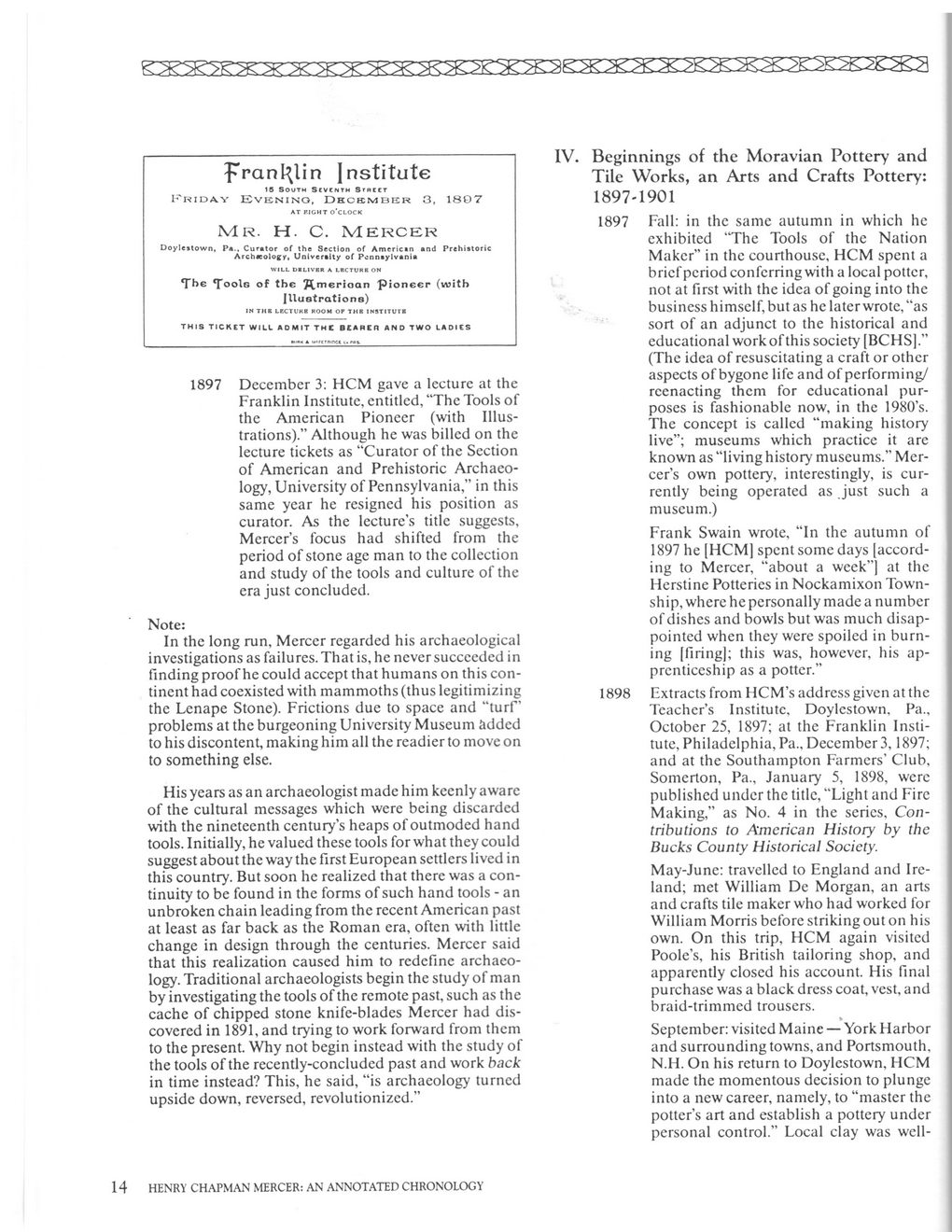This text was obtained via automated optical character recognition.
It has not been edited and may therefore contain several errors.
^ran^lin Institute 15 South Scvcnth Street Friday Evening, December 3, 1807 AT RIGHT O’CLOCK Mr. H. C. Mercer Doylestown, Pa., Curator of the Section of American and Prehistoric Archaeology, University of Pennsylvania WILL DBLIVBR A LBCTURB ON The T°ols of the Tlmerioan pioneer (with Illustrations) IN THB LECTUKB ROOM OP THB INSTITUT8 THIS TICKET WILL ADMIT THE BEARER AND TWO LADIES 1897 December 3: HCM gave a lecture at the Franklin Institute, entitled, “The Tools of the American Pioneer (with Illustrations).” Although he was billed on the lecture tickets as “Curator of the Section of American and Prehistoric Archaeology, University of Pennsylvania,” in this same year he resigned his position as curator. As the lecture’s title suggests, Mercer’s focus had shifted from the period of stone age man to the collection and study of the tools and culture of the era just concluded. Note: In the long run, Mercer regarded his archaeological investigations as failures. That is, he never succeeded in finding proof he could accept that humans on this continent had coexisted with mammoths (thus legitimizing the Lenape Stone). Frictions due to space and “turf’ problems at the burgeoning University Museum added to his discontent, making him all the readier to move on to something else. His years as an archaeologist made him keenly aware of the cultural messages which were being discarded with the nineteenth century’s heaps of outmoded hand tools. Initially, he valued these tools for what they could suggest about the way the first European settlers lived in this country. But soon he realized that there was a continuity to be found in the forms of such hand tools - an unbroken chain leading from the recent American past at least as far back as the Roman era, often with little change in design through the centuries. Mercer said that this realization caused him to redefine archaeology. Traditional archaeologists begin the study of man by investigating the tools of the remote past, such as the cache of chipped stone knife-blades Mercer had discovered in 1891, and trying to work forward from them to the present. Why not begin instead with the study of the tools of the recently-concluded past and work back in time instead? This, he said, “is archaeology turned upside down, reversed, revolutionized.” IV. Beginnings of the Moravian Pottery and Tile Works, an Arts and Crafts Pottery: 1897-1901 1897 Fall: in the same autumn in which he exhibited “The Tools of the Nation Maker” in the courthouse, HCM spent a brief period conferring with a local potter, not at first with the idea of going into the business himself, but as he later wrote, “as sort of an adjunct to the historical and educational work of this society [BCHS] (The idea of resuscitating a craft or other aspects of bygone life and of performing/ rcenacting them for educational purposes is fashionable now, in the 1980’s. The concept is called “making history live”; museums which practice it are known as “living history museums.” Mercer’s own pottery, interestingly, is currently being operated as just such a museum.) Frank Swain wrote, “In the autumn of 1897 he [HCM] spent some days [according to Mercer, “about a week”] at the Herstine Potteries in Nockamixon Township, where he personally made a number of dishes and bowls but was much disappointed when they were spoiled in burning [firing]; this was, however, his apprenticeship as a potter.” 1898 Extracts from HCM’s address given at the Teacher’s Institute, Doylestown, Pa., October 25, 1897; at the Franklin Institute, Philadelphia, Pa., December 3,1897; and at the Southampton Farmers’ Club, Somerton, Pa., January 5, 1898, were published under the title, “Light and Fire Making,” as No. 4 in the series, Contributions to American History by the Bucks County Historical Society. May-June: travelled to England and Ireland; met William De Morgan, an arts and crafts tile maker who had worked for William Morris before striking out on his own. On this trip, HCM again visited Poole’s, his British tailoring shop, and apparently closed his account. His final purchase was a black dress coat, vest, and braid-trimmed trousers. » September: visited Maine — York Harbor and surrounding towns, and Portsmouth, N.H. On his return to Doylestown, HCM made the momentous decision to plunge into a new career, namely, to “master the potter’s art and establish a pottery under personal control.” Local clay was well- HENRY CHAPMAN MERCER: AN ANNOTATED CHRONOLOGY

Bucks-Mont, Pennsylvania Bucks County Hist Soc - Henry Chapman Mercer (16)